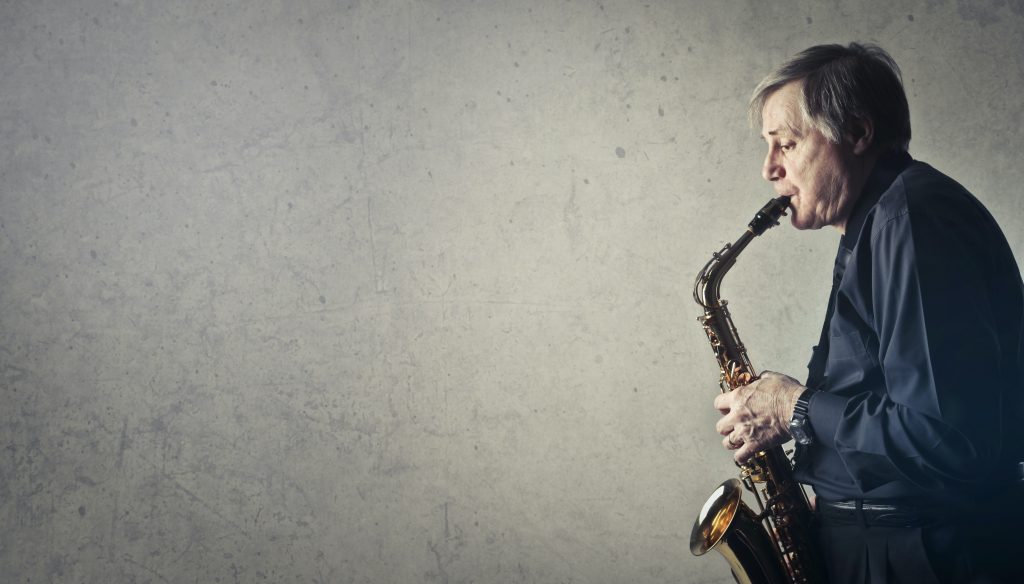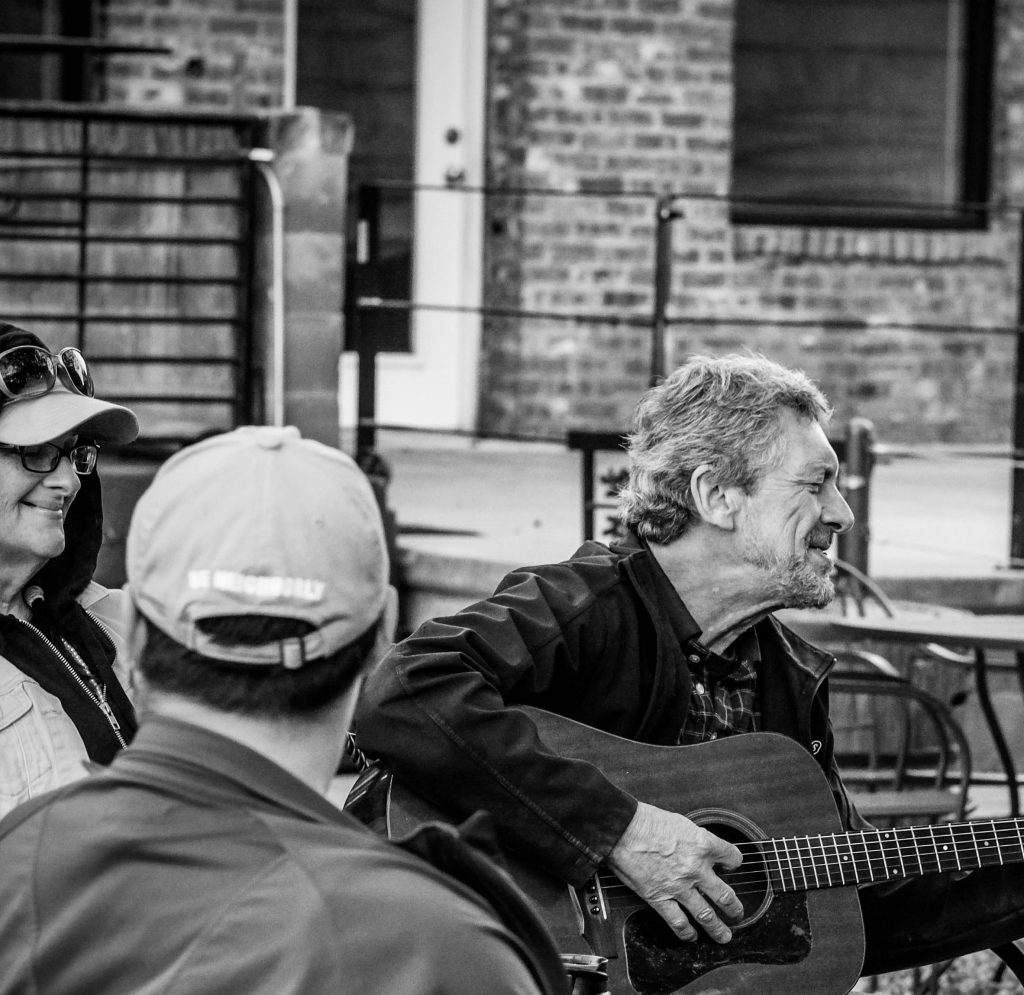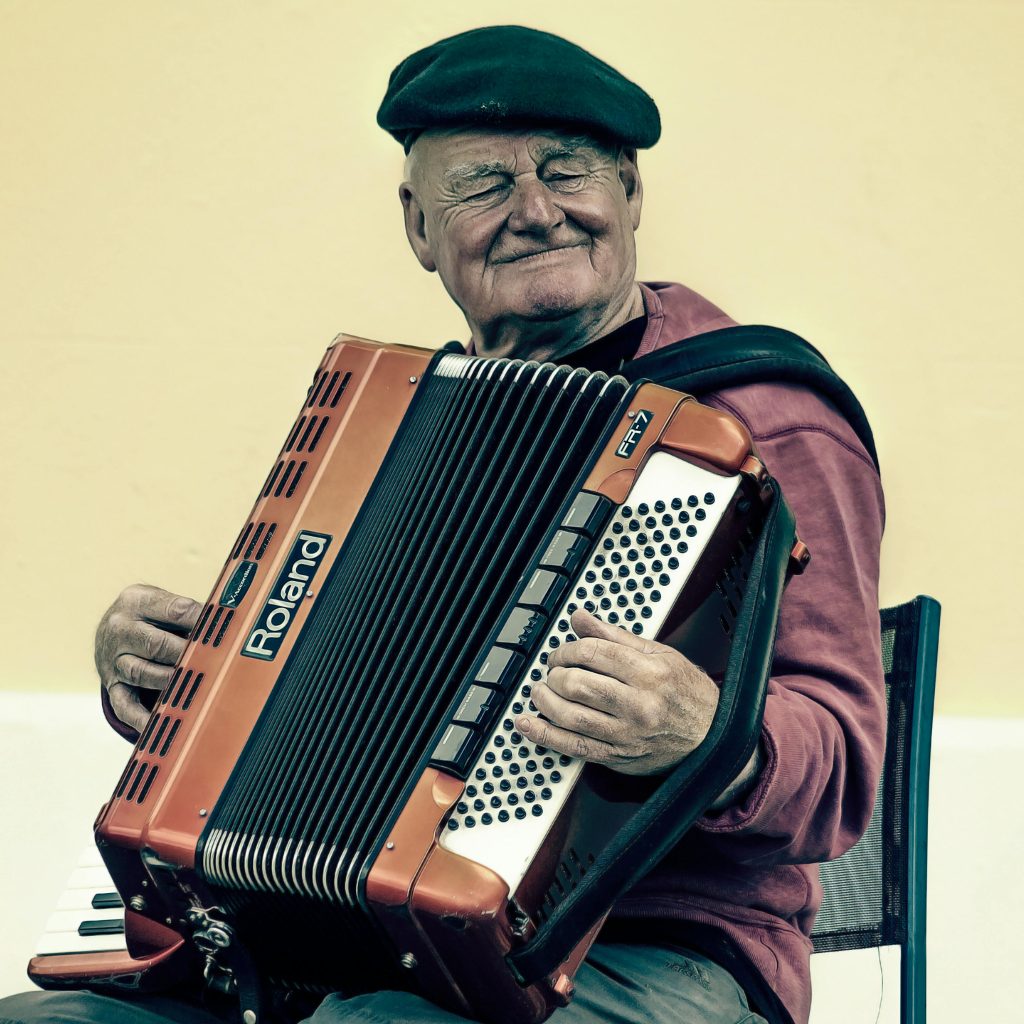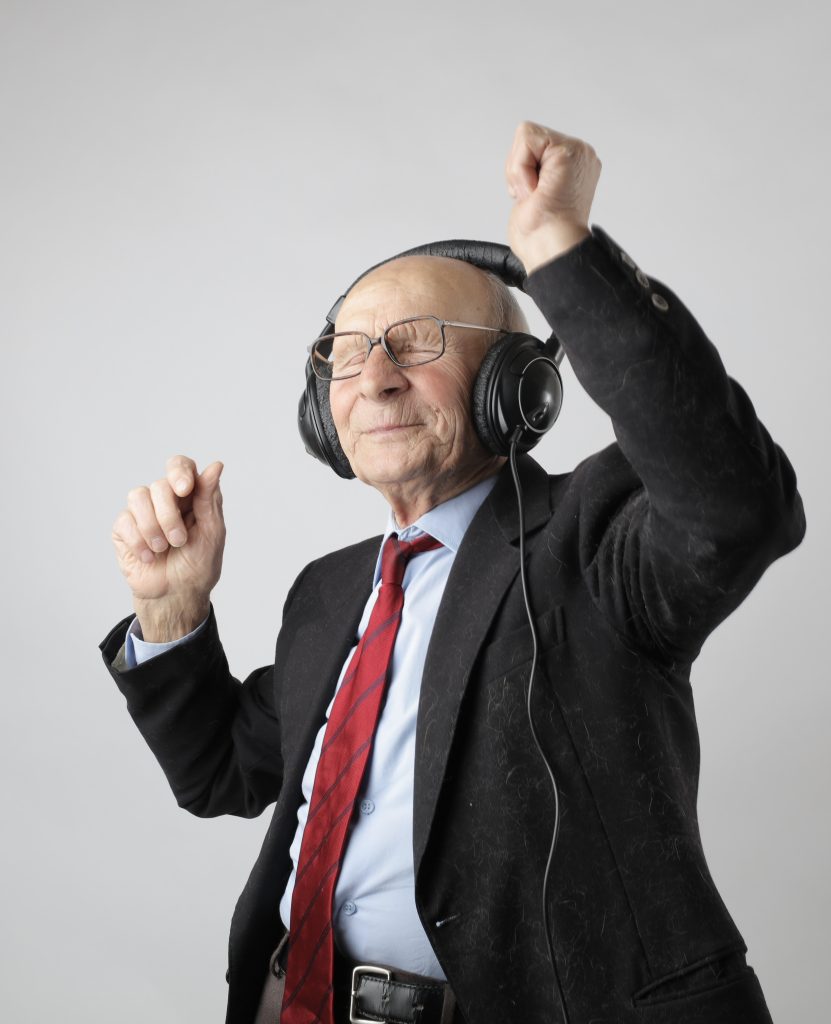Musicking in adulthood and advanced age: unsuspected benefits
- Arthur Douchet, Master’s Student in Musicology
- Andrea Creech, Professor, Schulich School of Music, McGill University
- Audrey-Kristel Barbeau, Professor in the Department of Music at the Université du Québec à Montréal
Playing music brings a multitude of benefits for adults of all ages. From stress reduction to cognitive enhancement, not to mention self-confidence and strengthening bonds with others. Music truly enriches adults’ lives significantly[1].

Musical creativity can shine anew in adulthood. Contrary to what one might think, it’s never too late to learn music[2]. With motivation and regular practice, adults can achieve a good, or even advanced, level[3]. Music stimulates different parts of the brain, which can improve their functioning, even for tasks unrelated to music[4].
Music finds a particular resonance in the hearts of those seeking comfort, such as in palliative care. Music therapy, which uses music to help patients, can be done individually or with family. It helps to create emotional bonds, manage stress during difficult changes, such as loss of autonomy[5].
Over the decades, music has proven to be much more than just a collection of harmonious notes. It is a companion throughout our journeys, creating deep feelings, weaving memories, and bonds that transcend the barriers of time. Music touches different parts of the brain and evokes various emotions[6]. Musical memory is particularly robust and stable, even resisting pathologies[7].
A renaissance of musical creativity
As people age, a unique form of creativity can awaken. Memories of our past experiences, travels, loves, and challenges blend together and become a source of inspiration. At a time in life when professional and family obligations are less demanding, one can explore new artistic adventures, such as composing music. The songs born at this time are not limited to a specific musical genre and reflect a wealth of emotions and thoughts from the individual.
People who have set aside their musical dreams due to their responsibilities sometimes find space to express their creativity through music and revitalize their artistic identity. This is even the case for professional musicians. Take the example of Joan Baez, a famous folk singer and civil rights activist, who astonished the world by releasing a critically acclaimed album at an advanced age[8]. Her album “Whistle Down the Wind” is a profound reflection on life, society, and the passage of time. Similarly, Leonard Cohen, known for his poetic lyrics, also released the album “You Want It Darker” shortly before his death at 82[9], in which he explores the themes of life and death. These examples illustrate how musical creation can serve as a canvas to paint emotions and experiences accumulated over the years, offering renewed creativity in advanced age.

Amateur musicians can also show creativity at an advanced age. In fact, creativity is not limited to professional musicians and can be expressed by anyone, in any circumstances of life[10]. For example, Gaston Meunier continued to make guitars at the age of 80, which are appreciated by musicians, both amateur and professional[11]. Moreover, a study revealed that the average age of amateur musicians is 36[12], indicating that music is a lasting passion accessible at any time of their lives, regardless of their professional career.
Whether they are professional or amateur musicians, everyone can continue to create and innovate, regardless of their age. Music can be the mirror of their lives and experiences, offering a unique perspective on the world. This demonstrates that musical creativity is not the exclusive domain of the young or professionals, but a source of fulfillment for everyone, at any stage of life.
However, older individuals do not turn to musical practice simply because they have more free time. Some choose to explore new artistic paths, while others seize the opportunity to resume long-ignored passions. This musical creativity can also arise from deep reflection on past experiences, accomplishments, and regrets in life. Some musicians are driven by the desire to leave an artistic legacy for future generations. Thus, musical creativity at this age can be a form of rebirth, but it can also be influenced by many factors, including the desire to express oneself differently and leave a significant imprint on the world of music.
Music and Brain Plasticity in Advanced Age

Playing music later in life can stimulate brain plasticity[13]. Contrary to the belief that only a young brain can learn to play a new instrument, recent research reveals that older adults also have a real capacity for musical learning[14]. For example, neuroscientist and musician Dr. Gottfried Schlaug found that learning a musical instrument in older adults can lead to positive structural changes in the brain, including an increase in white matter in areas related to auditory perception and motor coordination.
Older adults accumulate life experiences that help them understand the complexity of music, allowing them to quickly learn musical skills and grasp music theory in depth[15]. Far from being limited by age, brain plasticity at this stage of life develops with musical practice. This offers these older musicians the opportunity to master new instruments and techniques, broaden their musical horizons, and create a rich and varied sound universe[16].
Music at the Heart of Emotions and Well-being
In the context of palliative care, music can play a significant role for people at the end of life. Take the example of Henry, a patient with advanced Alzheimer’s whose video playing the piano and singing familiar songs captured the world’s attention. Even when verbal communication was lacking, music was able to revive memories buried in his memory and bring palpable joy to Henry[17]. His story illustrates music’s ability to overcome the barriers of illness and touch deep emotions.
Furthermore, music creates a bridge between the past and the present, offering comfort to patients at the end of life. A familiar melody not only evokes memories but reconnects patients with moments and people who shaped their journey. Music can soothe anxiety and pain and provide a means of expression for the complex emotions that often accompany this period. Whether through joyful melodies recalling happy days or more melancholic melodies reflecting regrets or giving voice to farewells, music provides patients with a way to express what may be difficult to put into words.

In this perspective, the use of music during palliative care can become a key contributor to patients’ overall well-being. Studies have shown that music can reduce agitation and anxiety, improve mood, and provide an overall sense of comfort[18] [19]. It can create a calm and soothing atmosphere in hospital rooms, offering a space of respite for patients and their families. Beyond its emotional impact, music can also help manage pain and act as a natural analgesic through the release of endorphins.
Through this emotional field, music can act as a bridge between the past, present, and even the future. It holds the potential to go beyond words and physical barriers and become a profoundly human means of communication where words seem inadequate. By weaving a tapestry of emotions and memories, music brings comfort and connection that defy the limits of time and the human condition.
There is still much to explore and discover in the field of music, including its link to mental health[20] [21] [22], pain management[23] [24] [25] [26], and access to music for the elderly and patients in palliative care[27]. Moreover, technological advancements open up new possibilities for creating, sharing, and experiencing music in ways that were previously unimaginable.[28] [29] [30]
At the dawn of each new melody, we are invited to delve into the infinite universe of music, explore its mysterious corners, and be carried away by its moving vibrations. Whether composing our own tunes, learning a new instrument, or letting the notes envelop us, music continues to reveal unexplored harmonies of life resonating with our existence.
[1] Les bienfaits de la pratique musicale pour les adultes. (2023, août 18). ICM. https://www.icm-musique.fr/le-blog/le-coin-des-curieux/les-bienfaits-de-la-pratique-musicale-pour-les-adultes/
[2] Bidet, A. (2021, mai 3). Le Staccato Musique Suspendue. Enseigner La Musique. https://enseigner-la-musique.fr/staccato-musique/
[3] Laflamme, K. (2020, mai 12). Débuter l’apprentissage de la musique à l’âge adulte. École de musique L’Accroche Notes. https://www.accrochenotes.ca/debuter-lapprentissage-de-la-musique-a-lage-adulte/
[4] Moussard, A., Rochette, F., & Bigand, E. (2012). La musique comme outil de stimulation cognitive. L’Année psychologique, 112(3), 499‑542. https://doi.org/10.3917/anpsy.123.0499
[5] Musique et massage en harmonie. (s. d.). Le Conseil des soins palliatifs. Consulté 20 octobre 2023, à l’adresse https://www.mcgill.ca/council-on-palliative-care/fr/article/musique-et-massage-en-harmonie
[6] Siag, J. (2023, février 13). Identifier les émotions par la musique. La Presse. https://www.lapresse.ca/societe/2023-02-13/identifier-les-emotions-par-la-musique.php
[7] Girard-Bossé, A. (2021, septembre 27). Quand la musique prend le contrôle de votre cerveau. La Presse. https://www.lapresse.ca/actualites/sciences/2021-09-27/quand-la-musique-prend-le-controle-de-votre-cerveau.php
[8] Bobolink Records (Réalisateur). (2018, janvier 8). Joan Baez—Whistle Down The Wind (Official Audio). https://www.youtube.com/watch?v=B5-e4qqvKck
[9] LeonardCohen (Réalisateur). (2016, septembre 21). Leonard Cohen—You Want It Darker (Audio). https://www.youtube.com/watch?v=v0nmHymgM7Y
[10] Vieillesse et créativité – Avant Âge. (s. d.). Consulté 21 octobre 2023, à l’adresse https://avant-age.ch/vieillesse-et-creativite/
[11] Nouvelliste, I. L., Le. (2021, avril 3). Fabricant de guitares à 80 ans. Le Soleil. https://www.lesoleil.com/2021/04/04/fabricant-de-guitares-a-80-ans-583cd41e15cc54217ccc67d2dffa21c8/
[12] Musiciennes et musiciens amateurs : un monde méconnu – Fragil – Culture, société, initiatives citoyennes
[13] Fauvel, B., Groussard, M., Desgranges, B. & Platel, H. (2012). Pratique musicale et plasticité cérébrale : l’expertise musicale permet-elle de se préserver du vieillissement neurocognitif ?. Revue de neuropsychologie, 4, 131-137. https://doi.org/10.1684/nrp.2012.0211
[14] La danse (comme la musique) modifie le cerveau de ceux qui en font souvent. (s. d.). Agence Science-Presse. Consulté 21 octobre 2023, à l’adresse https://www.sciencepresse.qc.ca/blogue/cerveau-niveaux/2019/09/09/danse-musique-modifie-cerveau-font-souvent
[15] Ferreri, L. (2017). Musique et plasticité cérébrale (J.-M. Rivière, Trad.). Revue internationale d’éducation de Sèvres, 75, Article 75. https://doi.org/10.4000/ries.5944
[16] Kubik, S. (2017, octobre 17). Développement du cerveau humain : Et si la musique s’en mêle ? France Musique. https://www.radiofrance.fr/francemusique/developpement-du-cerveau-humain-et-si-la-musique-s-en-mele-2226658
[17] Alive Inside: A Story of Music and Memory. Directed by Michael Rossato-Bennett, Projector Media, 2014.
[18] Magee, W. L., Clark, I., & Tamplin, J. (2017). The effect of group music therapy on quality of life for participants living with a severe and enduring mental illness. Journal of Music Therapy, 54(4), 379-396.
[20] Les bienfaits de la musique | UQAM. (2020, octobre 1). https://actualites.uqam.ca/2020/les-bienfaits-de-la-musique-sur-le-stress/
[21] Durand, C. (2023, mai 3). L’impact de la musique sur notre bien-être émotionnel et mental. Presse santé. https://www.pressesante.com/limpact-de-la-musique-sur-notre-bien-etre-emotionnel-et-mental/
[22] Musique : Ses bienfaits sur la santé mentale – OKTAV. (s. d.). Consulté 20 octobre 2023, à l’adresse https://www.oktav.com/fr/c/musique-sante-mentale
[23] Bird, A. (s. d.). Le pouvoir guérisseur du son : Musique et Gestion de la Douleur. Calm Radio. Consulté 20 octobre 2023, à l’adresse https://calmradio.com/fr/calmlife/4889-healing-power-of-music
[24] de Stoutz, J., & Guétin, S. (2016). Musicothérapie et douleur. Hegel, 2(2), 193‑193. https://doi.org/10.3917/heg.062.0193
[25] Music Care—Thérapie digitale et musicale contre la douleur. (2021, décembre 9). https://cemusique.org/therapie-musique-douleurs-music-care/
[26] Musicothérapie et douleur. (s. d.). SFETD – Site web de la Société Française d’Etude et du Traitement de la Douleur. Consulté 20 octobre 2023, à l’adresse https://www.sfetd-douleur.org/musicotherapie-et-douleur/
[27] Fourage, C. (2019). La musicothérapie en soins palliatifs : La vie jusqu’au bout. Jusqu’à la mort accompagner la vie, 139(4), 83‑92. https://doi.org/10.3917/jalmalv.139.0083
[28] Musique et tech : L’influence de la technologie sur la musique de demain. (2022, février 2). https://www.wildcodeschool.com/fr-fr/blog/influence-tech-musique-technologie-futur-intelligence-artificielle-streaming
[29] Caltabellotta, V. (2021, avril 28). Musique et technologie. Le digital pour tous. https://ledigitalpourtous.fr/2021/04/28/musique-et-technologie/
[30] Musique : Nouvelles technologies, nouveaux usages. (2019, juin 18). Les Echos. https://www.lesechos.fr/partenaires/econocom/musique-nouvelles-technologies-nouveaux-usages-1029176